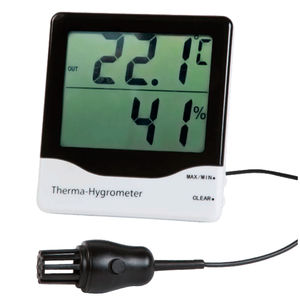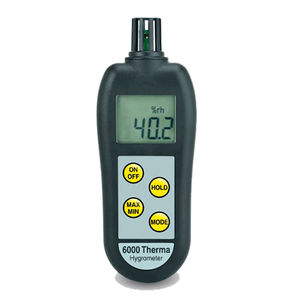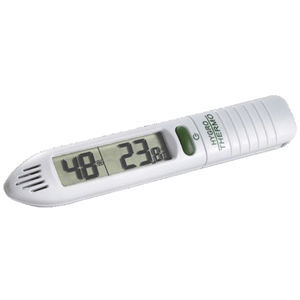
- Company
- Products
- Catalogs
- News & Trends
- Exhibitions
Analog psychrometer 803-4006temperaturerelative humidity
Add to favorites
Compare this product
Characteristics
- Display
- analog
- Measured value
- temperature, relative humidity
- Temperature
Min.: 0 °C
(32 °F)Max.: 50 °C
(122 °F)- Relative humidity
Min.: 3 %
Max.: 100 %
Description
Relative humidity, vapour tension and dew point are determined using a psychrometer. This device consists of a set of two equal thermometers: one of them, called "dry thermometer", that serves simply to get the temperature of the air, and the other, called "wet thermometer", which has a tank covered with a wet muslin and a tank of distilled water connected through a wick
Operation: the water that soaks the muslin evaporates, but to do so requires heat, obtained from the thermometer, that lowers the temperature. The evaporated water is replaced by water coming through the wick. Transport is automatically adjusted, establishing a stationary system that depends on the rate of evaporation. The thermometer receives the same amount of water that evaporates.
The rate of evaporation, i.e. the amount of evaporated water depends on moisture in the air, since if the air is saturated it is clear that it will not support any more steam, while if it is very dry, evaporation will be very active. On the other hand, the drop in temperature caused by evaporation depends, at the same time, on evaporation speed, because also this side leads to a stationary balance between heat lost due to evaporation and the received from outside, so the drop in temperature does not progress indefinitely, rather it stops at a more or less low point of equilibrium
Catalogs
Related Searches
- Temperature probe
- Resistance temperature probe
- Digital pyrometer
- Industrial pyrometer
- Pt100 temperature probe
- Infrared pyrometer
- °C pyrometer
- Stainless steel temperature probe
- Hand-held thermometer
- Waterproof thermometer
- Stainless steel pyrometer
- Analog thermometer
- RTD temperature probe
- Precision pyrometer
- Pt1000 temperature probe
- Non-contact pyrometer
- Fixed pyrometer
- Probe thermometer
- Resistance thermometer
- °F pyrometer
*Prices are pre-tax. They exclude delivery charges and customs duties and do not include additional charges for installation or activation options. Prices are indicative only and may vary by country, with changes to the cost of raw materials and exchange rates.












